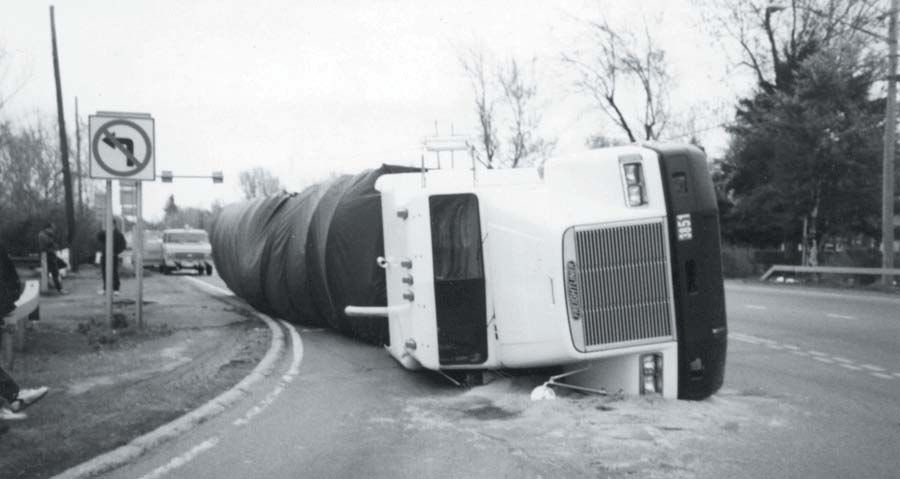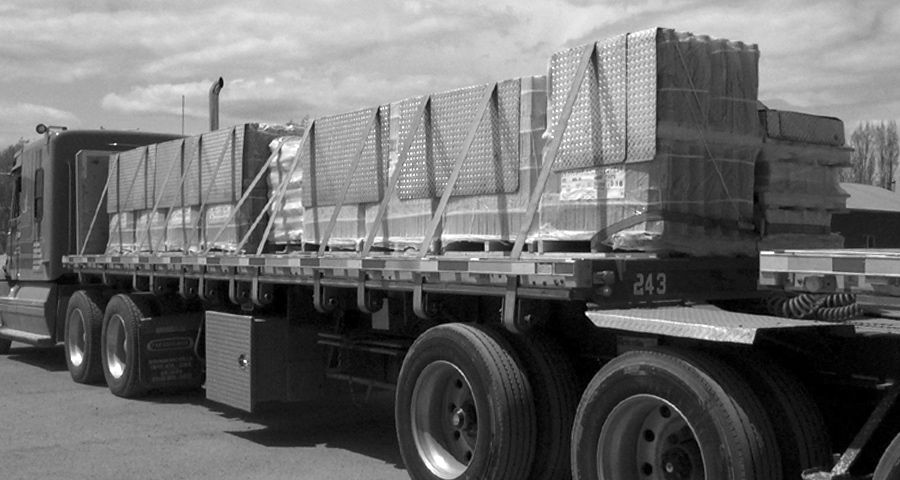Note: Your are not logged in. We can not keep your scores or track your progress unless you Register and Log In
Driver's Handbook on Cargo Securement
Chapter 1: Fundamentals of Cargo Securement
Guiding Principle of Cargo Securement:
Cargo being transported on the highway must remain secured on or within the transporting vehicle.
The cargo must remain secured on or in the transporting vehicle:
- Under all conditions that could reasonably be expected to occur in normal driving.
- When a driver is responding in all emergency situations, EXCEPT when there is a crash.
Consequences Of Unsecured Cargo

- Loss of life
- Loss of load
- Damage to the cargo
- Damage to the vehicle
- Issuance of citations/fines to driver/carrier
- The vehicle being placed Out-of-Service.
- A crash
It is assumed that heavy loads carried under special permits would be subject to securement standards contained in the special permit, which may differ from the North American Cargo Securement Standard. Check with your Federal, Provincial, or State government for any permit requirements.
North American Cargo Securement Standard
What does the Standard cover? (Section 1.1)
Vehicles
- Commercial vehicles (including a combination of vehicles) that are operated on a highway and have a gross vehicle rating over 4,500 kg (10,000 lb.)
Cargo
-
Any cargo and dangerous goods/hazardous materials, including:
- All general freight.
- All equipment carried for vehicle operation.
- Intermodal containers and their contents.
- Some specific commodities have additional or different securement requirements (see later sections of this Handbook).
- Additional requirements under separate regulations may also apply for transportation of certain types of dangerous goods or hazardous materials.

Note:
It is assumed that heavy loads carried under special permits would be subject to securement standards contained in the special permit, which may differ from the North American Cargo Securement Standard. Check with your Federal, Provincial, or State government for any permit requirements.
 Related Cargo Securement Terms That Every Driver Should Know:
Related Cargo Securement Terms That Every Driver Should Know:
-
Anchor point:
Part of the structure, fitting, or attachment on a vehicle or cargo to which a tiedown is attached.
-
Deck:
The load carrying area of a truck, trailer, or intermodal container.
-
Wedge:
A tapered piece of material, thick at one end and thin at the other, used to help keep cargo from moving.
Multiple-Choice Questions:
The North American Cargo Securement Standard cover vehicles weighing:
- Less than 10,000 lbs
- Over 4,500 lbs
- Over 10,000 lbs
- 26,001 lbs
North American Cargo Securement Standard
What does the Standard cover? (Section 1.1)
- Commercial vehicles (including a combination of vehicles) that are operated on a highway and have a gross vehicle rating over 4,500 kg (10,000 lb.)
Vehicles
The load carrying area of a truck, trailer, or intermodal container is referred to as the:
- Headboard
- Bulkhead
- Well
- Deck
Deck:
The load carrying area of a truck, trailer, or intermodal container.
What types of freight need to be secured properly?
- Intermodal containers.
- Equipment used for vehicle operation.
- All freight should always be properly secured while driving.
- Hazardous materials.
-
Any cargo and dangerous goods/hazardous materials, including:
- All general freight.
- All equipment carried for vehicle operation.
- Intermodal containers and their contents.
- Some specific commodities have additional or different securement requirements (see later sections of this Handbook).
- Additional requirements under separate regulations may also apply for transportation of certain types of dangerous goods or hazardous materials.
Cargo
Which of the following is not a reason why loads should be secured?
- Prevent damage to the cargo
- Avoid fines and citations
- Prevent loss of load
- Make it look pretty
Why secure your load? To prevent:
- Loss of life
- Loss of load
- Damage to the cargo
- Damage to the vehicle
- Issuance of citations/fines to driver/carrier
- The vehicle being placed Out-of-Service.
- A crash
In cargo securement, a wedge is defined as:
- A short piece of material, usually wood, nailed to the deck to reinforce blocking.
- The depression formed between two cylindrical articles when they are laid with their eyes horizontal and parallel against each other.
- A tapered piece of material, thick at one end and thin at the other, used to help keep cargo from moving.
- A rail along the side of a vehicle that protects the side of the vehicle from impacts.
Wedge:
A tapered piece of material, thick at one end and thin at the other, used to help keep cargo from moving.
An anchor point is defined as:
- The load carrying area of a truck, trailer, or intermodal container.
- Part of the structure, fitting, or attachment on a vehicle or cargo to which a tiedown is attached.
- A rail along the side of a vehicle that protects the side of the vehicle from impacts.
- A vertical barrier across the front of the deck of a vehicle to prevent forward movement of cargo.
Anchor point:
Part of the structure, fitting, or attachment on a vehicle or cargo to which a tiedown is attached.
Complete!
You can Return To The Table Of Contents







 TT On Facebook
TT On Facebook